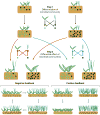Microbial population and community dynamics on plant roots and their feedbacks on plant communities
- PMID: 22726216
- PMCID: PMC3525954
- DOI: 10.1146/annurev-micro-092611-150107
Microbial population and community dynamics on plant roots and their feedbacks on plant communities
Abstract
The composition of the soil microbial community can be altered dramatically due to association with individual plant species, and these effects on the microbial community can have important feedbacks on plant ecology. Negative plant-soil feedback plays primary roles in maintaining plant community diversity, whereas positive plant-soil feedback may cause community conversion. Host-specific differentiation of the microbial community results from the trade-offs associated with overcoming plant defense and the specific benefits associated with plant rewards. Accumulation of host-specific pathogens likely generates negative feedback on the plant, while changes in the density of microbial mutualists likely generate positive feedback. However, the competitive dynamics among microbes depends on the multidimensional costs of virulence and mutualism, the fine-scale spatial structure within plant roots, and active plant allocation and localized defense. Because of this, incorporating a full view of microbial dynamics is essential to explaining the dynamics of plant-soil feedbacks and therefore plant community ecology.
Figures


References
-
- Alizon S, Hurford A, Mideo N, van Baalen M. Virulence evolution and the trade-off hypothesis: history, current state of affairs and the future. J Evol Biol. 2009;22:245–59. - PubMed
-
- Alizon S, van Baalen M. Multiple infections, immune dynamics, and the evolution of virulence. Am Nat. 2008;172:E150–68. - PubMed
-
- Antolin MF. Unpacking beta: within-host dynamics and the evolutionary ecology of pathogen transmission. Annu Rev Ecol Evol Syst. 2008;39:415–37.
-
- Ashton IW, Miller AE, Bowman WD, Suding KN. Nitrogen preferences and plant-soil feedbacks as influenced by neighbors in the alpine tundra. Oecologia. 2008;156:625–36. - PubMed
Publication types
MeSH terms
Grants and funding
LinkOut - more resources
Full Text Sources

